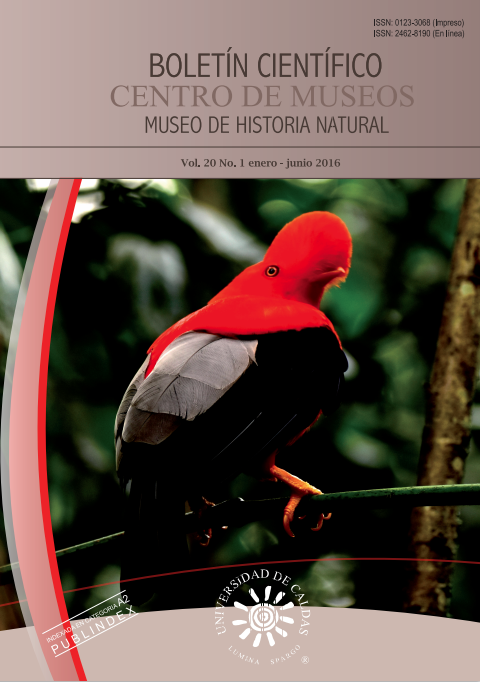Authors
Abstract
Some aspects of the biology and life cycle of Metamorpha elissa elissa are presented for the first time based on the study of the different preimaginal instars. The species usesTrichanthera gigantea (Acanthaceae) as host plant for its larvae. From three eggs obtained at the moment they were ovipositedit was possible to obtain the complete life cycle under lab controlled conditions after 37 days. A brief comparison of the life cycle times with the Siproeta epaphus Latreille and Siproeta stelenesLinnaeus species, for being the closest phylogenetically is made.
Keywords
References
CONSTANTINO, L. M. 1998.- Butterfly life history studies, diversity, ranching and conservation in the Chocó rain forests of Western Colombia.SHILAP Revta Lepid. 26 (101):19-39.
CONSTANTINO, L.M. 2002.- Utilización de Trhichantera gigantean como alimento para cría de seis especies de mariposas diurnas: 195-203. En: Ospina, S. & Murgueitio, E. (Eds.) Tres especies vegetales promisorias: Nacedero Trichantera gigantea, Botón de Oro Tithonia diversifolia y Bore Alocasia macrorrhiza. CIPAV, Convenio Andrés Bello CAB y Colciencias. CIPAV, Cali, Colombia.
CHUMPITASI, M. E. 2002.- Life history of Siproeta epaphus epaphus (Latreille). News of the Lepidopterists' Society. 44(1): 12, 33.
FOX, R. M. & ALDEN C. F. 1971.- The butterflies of the genera Siproeta and Metamorpha (Lepidoptera: Nymphalidae). Annals of the Carnegie Museum 43(8): 223-247, 6 pls. (24 December) [general; morphology; new subspecies: Siproeta superbaeuoe, Metamorpha elissa pulsitia].
GOWDA, J. H. 1990.- Evaluación de dos especies arbóreas agroforestales del Valle del Cauca en la parte central de Colombia Erythrina poeppigiana y Trichanthera gigantea. Sveriges Lantbruks university et. Informe 126. IRDC Uppsala. 17 pp.
GREENEY, H. F., DYER, L. A. & SMILANICH,A. M. 2012.- Feeding by lepidopteran larvae is dangerous: A review of caterpillars' chemical, physiological, morphological, and behavioural defenses against natural enemies. Invertebrate Survival Journal 9:7–34.
HÜBNER, J.- [1819]a. Verzeichniss... Augsburg, Jacob Hübner. (2-8): 17-128 ([early 1819]) [general; new taxa; Metamorpha (new genus) elissa.
JARAMILLO, C. J. & CORREDOR, G. 1989.- Plantas forrajeras: proteína barata para el ganado. Revista Federación Nacional de Cafeteros de Colombia.
MASTERS, J. H.- 1973c. Notes on Siproeta and Metamorpha with figures of Siproeta epaphus gadoui Masters (Nymphalidae). Journal of the Lepidopterists' Society 27(3): 235-237, 1 fig.
MURGUEITIO. E. 1989.- Los árboles forrajeros en la alimentación animal. (en): Primer seminario regional de biotecnología. CVC-Universidad Nacional de Colombia. 5-9.
PÉREZ-ARBELÁEZ, E.- 1990. Plantas útiles de Colombia. Editorial Víctor Hugo, Medellín. 14th edition. 832 pp.
SARRIA, P. 1994.- Efecto del nacedero (Trichanthera gigantea) como reemplazo parcial de la soya en cerdas en gestación y lactancia recibiendo una dieta básica de jugo de caña.Livestock Research for Rural Development 6(1): 62-73.
VALENCIA, C., GIL, Z., CONSTANTINO, L.M.- 2005. Mariposas diurnas de la zona central cafetera colombiana. Guía de campo. Chinchiná (Colombia), Cenicafé.
YOUNG, A. M.- 1972e. The ecology and ethology of the tropical nymphaline butterfly, Victorina epaphus. I. Lifecycle and natural history. Journal of the Lepidopterists' Society 26(3): 155-170.

 PDF (Español)
PDF (Español)
 FLIP
FLIP






















